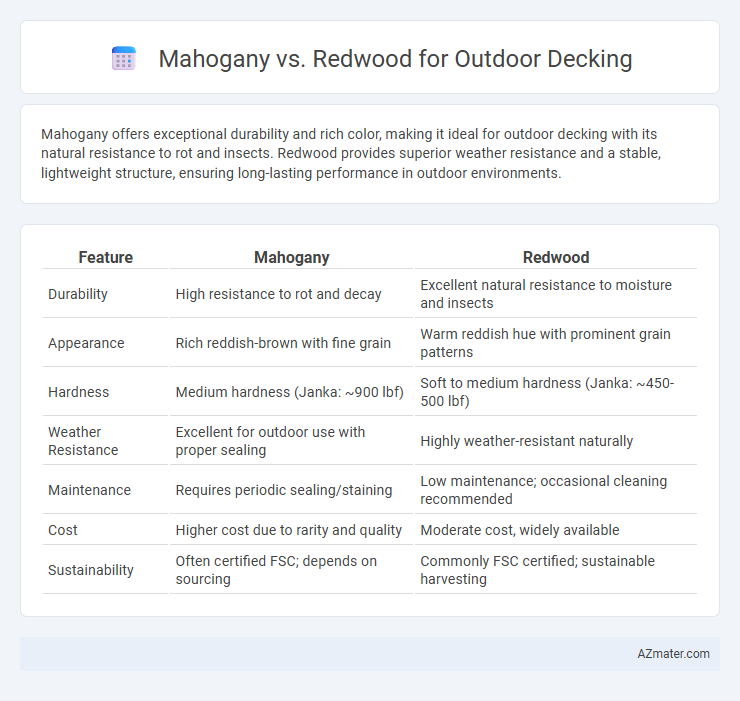Mahogany offers exceptional durability and rich color, making it ideal for outdoor decking with its natural resistance to rot and insects. Redwood provides superior weather resistance and a stable, lightweight structure, ensuring long-lasting performance in outdoor environments.
Table of Comparison
| Feature | Mahogany | Redwood |
|---|---|---|
| Durability | High resistance to rot and decay | Excellent natural resistance to moisture and insects |
| Appearance | Rich reddish-brown with fine grain | Warm reddish hue with prominent grain patterns |
| Hardness | Medium hardness (Janka: ~900 lbf) | Soft to medium hardness (Janka: ~450-500 lbf) |
| Weather Resistance | Excellent for outdoor use with proper sealing | Highly weather-resistant naturally |
| Maintenance | Requires periodic sealing/staining | Low maintenance; occasional cleaning recommended |
| Cost | Higher cost due to rarity and quality | Moderate cost, widely available |
| Sustainability | Often certified FSC; depends on sourcing | Commonly FSC certified; sustainable harvesting |
Introduction: Mahogany vs Redwood Decking
Mahogany and redwood are two popular choices for outdoor decking due to their durability and natural beauty. Mahogany offers a rich, dark reddish-brown hue with exceptional resistance to rot and insects, making it ideal for long-lasting outdoor projects. Redwood features a warm, golden-red tone and contains natural tannins that protect against decay, providing a stable and visually appealing decking option.
Overview of Mahogany and Redwood
Mahogany is prized for its rich reddish-brown color, density, and natural resistance to rot and insect damage, making it a durable choice for outdoor decking. Redwood offers a warm, reddish hue with lightweight strength and exceptional resistance to decay and moisture, often favored for its natural stability in outdoor environments. Both woods provide excellent longevity and aesthetic appeal, though mahogany tends to be harder and more resistant to wear, while redwood remains dimensionally stable and environmentally sustainable.
Durability and Lifespan Comparison
Mahogany offers excellent durability for outdoor decking, resisting decay and insect damage with a typical lifespan of 25 to 40 years when properly maintained. Redwood also boasts strong durability, especially its heartwood, which can last between 20 and 30 years due to its natural tannins that protect against rot and pests. Both woods require regular sealing and care, but mahogany generally outperforms redwood in longevity and resistance under harsh weather conditions.
Weather and Moisture Resistance
Mahogany exhibits excellent weather and moisture resistance due to its dense grain and natural oils, making it highly durable under varying outdoor conditions. Redwood contains natural tannins that provide strong resistance to decay and insects, though it is slightly less dense than mahogany, which can lead to more moisture absorption over time. Both woods perform well for outdoor decking, but mahogany's superior hardness and resistance to warping offer enhanced longevity in humid or wet climates.
Maintenance Requirements
Mahogany requires regular oiling and sealing to maintain its rich color and prevent moisture damage, while redwood's natural tannins provide moderate resistance to decay and insect attacks, reducing the frequency of upkeep. Both woods benefit from annual cleaning with mild soap and water to remove dirt and mildew, but mahogany's dense grain demands more vigilant moisture control to prevent warping. Redwood decking typically endures with less intensive maintenance, making it a favorable choice for homeowners seeking durability with minimal care.
Cost and Budget Considerations
Mahogany for outdoor decking typically incurs higher upfront costs due to its luxury status and durability, making it a premium choice for budget-conscious homeowners. Redwood offers a more affordable alternative with natural resistance to decay and insect damage, providing long-term value through lower maintenance expenses. Budget considerations should weigh initial investment against lifespan, with mahogany favored for upscale projects and redwood suitable for cost-effective, durable decking.
Environmental Impact and Sustainability
Mahogany offers superior durability and resistance to decay, reducing the need for frequent replacements and lowering overall environmental impact in outdoor decking. Redwood is naturally pest-resistant and requires less chemical treatment, promoting sustainability through minimal environmental pollution. Both woods come from responsibly managed forests, but certified mahogany often has stricter harvesting regulations, enhancing its sustainability profile compared to some redwood sources.
Aesthetic Differences: Color and Grain
Mahogany decking showcases a rich, reddish-brown hue with a fine, straight grain that deepens over time, offering an elegant and luxurious appearance. Redwood displays a warm, natural reddish tone with prominent, varied grain patterns that provide a rustic and vibrant aesthetic. Both woods enhance outdoor spaces with their distinct color depth and grain texture, influencing the overall ambiance of the deck.
Installation and Workability
Mahogany offers superior workability for outdoor decking due to its fine grain and smooth texture, allowing easier cutting, nailing, and sanding compared to Redwood. Redwood, while slightly softer and less dense, is also straightforward to install but may require additional care to avoid splintering. Both woods respond well to common fastening methods, though Mahogany's stability reduces the risk of warping during and after installation.
Which is Best for Your Outdoor Deck?
Mahogany offers superior durability, rich color, and natural resistance to decay, making it an excellent choice for outdoor decking that demands longevity and aesthetic appeal. Redwood provides a softer texture with outstanding weather resistance and natural insect repellence, ideal for decks exposed to varying climatic conditions. Choosing between mahogany and redwood depends on your priorities for strength, maintenance, and environmental exposure.

Infographic: Mahogany vs Redwood for Outdoor Decking
 azmater.com
azmater.com